Remembering Ron
by Ed Sauter
Those who knew Ron Colvin (RC) will never forget him. Beneath the ever-present beard, overalls, Hawaiian shirts and sandals was a kind, smart, and caring individual who would do anything to make life better for those who worked with him.
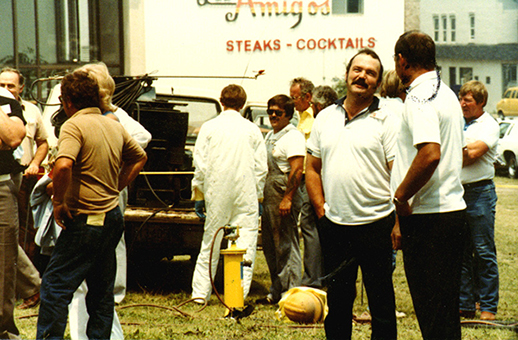
Ron Colvin at a CFA event in 1982 – Racine, Wisconsin.
Ron was a little unconventional in his appearance and approach to things, but in a great way. I worked with Ron (I never did call him RC) throughout my tenure as executive director of the Concrete Foundations Association. He had strong ideas and made certain they were heard. If he thought an idea was “bull-xxxx,” he said so. When he became treasurer of the association, I always had to be on my toes because Ron knew more about financial reports than most people, especially me. He mentioned to me that he had worked in the banking industry at one time, but a certain disagreement with management led him down another path. He would always ask me questions I didn’t know the answers to, and I knew better than to try to bluff my way through. I’d have to say, “I’ll get back to you on that one, Ron—now if we can move on,” hoping he wouldn’t push the issue. While he may have put me on the spot when it came to financial reports, he had my back on every important issue that came to the table.
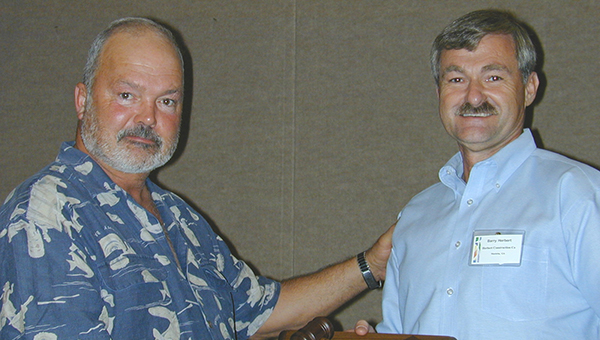
Ron Colvin (left) congratulates Barry Herbert (right) and presents him with the CFA President’s plaque for two years of service.
Ron’s passing caused me also to reflect on how important all of you have been to us. Scott and I were elected to the board at the same time, and our first meeting was also Ed’s first as head of the association. This particular group has been very important to the success of our company (we still use the footing system Ron showed us 25 or 30 years ago), but more importantly, I consider each of you a close friend. My only regret is that we see so little of one another now days. – Barry Herbert, Herbert Construction Company
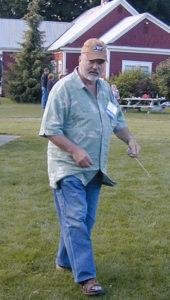
Always a part of the fun. Ron here heads off to practice with his yo-yo after a lesson from the “Yo-Yo Man” at CFA Convention 2002 – Mt. Hood, OR
I talked Ron into serving on the ACI 332 Committee (Residential Concrete Construction) along with Barry Herbert when I chaired the committee (which was all about residential concrete construction) because it had nobody with true construction experience participating and representing the interest of the residential contractor. How can you talk about building with concrete without a voice from those who actually do the work? (Note: Brent Anderson and Buck Bartley were also on that committee and became great contributors.) His outspoken and frank comments, supported by Buck, Barry and Brent, sometimes left heads turning, but they almost always won the arguments.
Ron made me think hard about the CFA and about my business. I think he made the CFA a better association, and I am sure glad I served with him. There have been some colorful people in our association – and Ron may have been the most unique! Kind of crazy how long ago it was that Bill, Arie, Bruce, me, Barry and the others in our group were on the board with Ron. Thank you all for the memories!! – Scott Smith, MPW Construction Services
Ron had a thirst for knowledge when it came to everything related to concrete and foundations. To board meetings Ron would often arrive several days early, in his Cadillac, and drive around the town to see how others were doing things (and I’m sure correcting some of the things they were doing wrong).
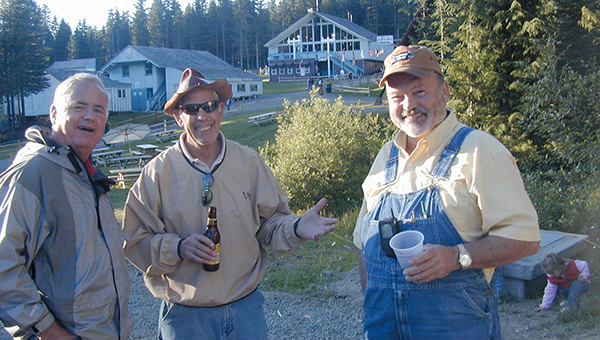
An after-education conversation in Mt. Hood, OR – CFA Convention 2002. Gary Bromley (left), Buck Bartley (center), Ron Colvin (right).
I remember at Mount Hood he suggested we go for a drive through the mountain back roads to look at the scenery. I assumed we would be doing it with a 4-wheel drive Jeep, but no: he picked us up in his rental Caddy.
The last time I saw Ron was at his pool hall in Berrien Springs. Ron told me he had always wanted to have his own pool hall and he fulfilled that dream after “trying” to retire from the foundation wall business. My wife and I were traveling with some friends on our way back from a wedding in Michigan and I decided to stop in, unannounced, to see if he might be there. I had no idea where the business was located, but I figured I’d just stop in town and inquire at the local hardware store as to where I might find Ron Colvin. “Ron Who?” he said. Then it hit him: “Oh, you mean RC. He’ll be at his pool hall just outside of town.”
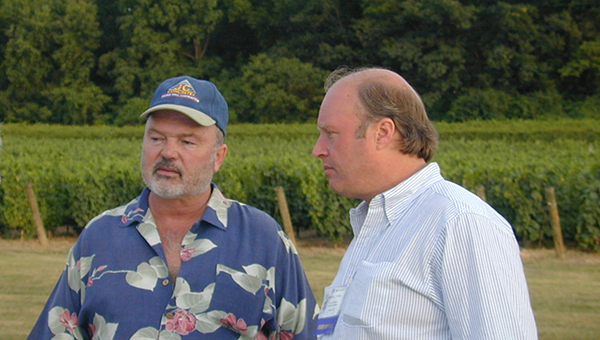
Ron Colvin (left) and Richard Crosby (right) engaged in one of their many talks on the value of business education topics. CFA Convention 2001 – Niagara Falls, Ontario
I jokingly told my wife and friends as we walked in, “Just look for the big guy with overalls, a Hawaiian shirt and sandals.” Sure enough there he was, dressed in his “working attire,” sitting on a stool, working out the details to his next pool tournament. He welcomed us with open arms and seemed disappointed that we couldn’t stay more than a couple of hours. He always had time to offer advice and opinions. The world could use a few more RC’s. He will be missed by many.
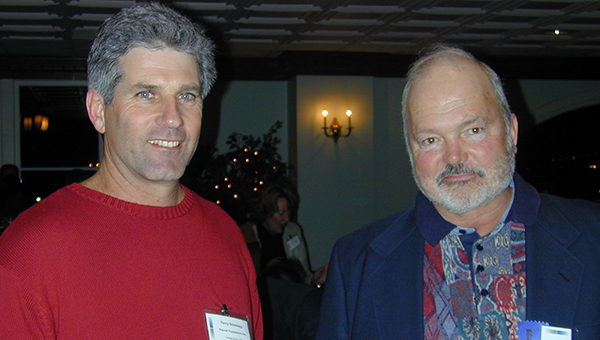
One of the few captured photos of Ron in a blazer. Terry Schniepp (left) and Ron Colvin (right).
Twisted Steel Micro-Rebar in Load-Carrying Concrete Walls
by Samhar Hoz, Jeff Novak, Luke Pinkerton
Concrete walls are widely used in building construction. Concrete is strong in compression; however, its tensile strength is only 8 to 15 percent of the compressive strength. Thus, plain concrete does not have good tensile properties. Cracks can develop due to loads, restrained shrinkage, or temperature changes that give rise to tensile stresses in excess of the concrete tensile strength.
Historically, many walls have been constructed of plain concrete. Modern codes, however, only allow plain concrete walls to be used in limited circumstances, where the walls are inherently stable. Design provisions for plain concrete are found in ACI 318-14 (1) and ACI 332-14 (2).
Reinforced walls are designed according to ACI 332-14 using rebar to increase their structural capacity. The minimum wall reinforcement required by ACI 332 is provided primarily for control of cracking and temperature stresses. Also, the minimum vertical wall reinforcement required by ACI 332 increases the strength of a wall. However, most wall designs provide standard diameter bars that are widely distributed and only carry load effectively after the concrete has cracked.
An alternative way to reinforce concrete walls is by using twisted steel micro-rebar (TSMR). TSMR reinforced concrete refers to concrete reinforced with short, randomly oriented twisted steel filaments. TSMR is fully anchored in concrete using continuous twisted rib deformations along the length of the shaft, similar to rebar. Because this type of reinforcement is distributed throughout the matrix and is fully anchored, it carries load both before and after the concrete develops cracks. In addition to its load-carrying capacity, TSMR provides redistribution of loads, potential reduction in crack widths, and increased durability of the finished structure. The degree to which these benefits are realized depends on the amount of TSMR added to the concrete mix. The mechanisms of how TSMR provides these benefits and how TSMR reinforced concrete can be used in practices is the subject of this paper.
The International Residential Code (IRC) governs the construction of walls used in residential structures (2). This building code basically references ACI 332 or ACI 318 (3) for the design of concrete structures. Although TSMR is not referenced in the IRC, the code does allow the use of alternative products as long as they undergo a detailed review process. The alternate means of code compliance (AMC) provision is in Section 104.11 of the 2015 IRC.
R104.11 Alternative materials, design and methods of construction and equipment. The provisions of this code are not intended to prevent the installation of any material or to prohibit any design or method of construction not specifically prescribed by this code, provided that any such alternative has been approved. An alternative material, design or method of construction shall be approved where the building official finds that the proposed design is satisfactory and complies with the intent of the provisions of this code, and that the material, method or work offered is, for the purpose intended, not less than the equivalent of that prescribed in this code. Compliance with the specific performance-based provisions of the International Codes shall be an alternative to the specific requirements of this code. Where the alternative material, design or method of construction is not approved, the building official shall respond in writing, stating the reasons why the alternative was not approved.
Evaluation reports (ERs), sometimes called code reports, are based on acceptance criteria (AC) or evaluation criteria (EC) and have been used by the construction industry for many decades. They are used to help assess a product’s code compliance through the code’s specified AMC provision and are typically used for products or systems not addressed in the code. They are also provided to help the building official and design professional determine if products or systems meet the prescriptive requirements and/or intent of the code. ERs have facilitated the use of new, innovative products through an evolving review and implementation process. They have also been used for products that are covered by the code as well as for times when there is some ambiguity in the code provisions. ERs have become a tool to facilitate, expedite and, in some cases, improve the design, building permit, construction, inspection and quality confirmation processes.
Helix TSMR received a Uniform-ES code approved evaluation report ER-0279 (4) in 2013, which states that Helix TSMR can be used as primary concrete reinforcement for structural applications.
TSMR Mechanism
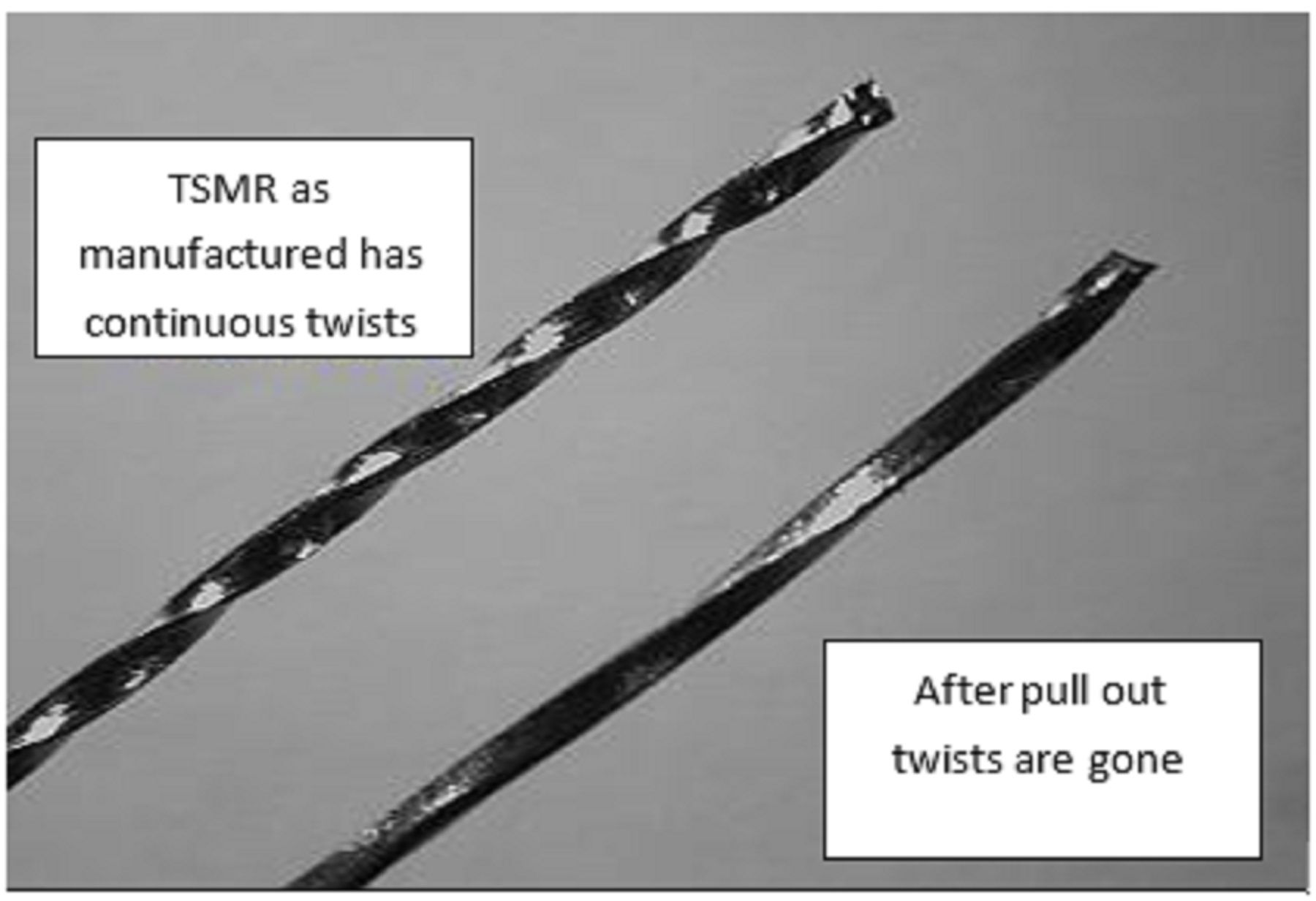
Figure 1: TSMR pullout behavior.
TSMR is an engineered product that substantially reduces the formation of cracks by increasing the tensile strain capacity of the concrete. This reduction or elimination of cracks optimizes the concrete’s durability. TSMR pieces are uniformly distributed, providing effective three-dimensional reinforcement.
As the concrete hardens and shrinks, microscopic cracks develop. TSMR intersects these micro-cracks, preventing them from developing into macro-cracks and potential problems. Today, the designer and contractor do not have to settle for the rebar or wire mesh method and gamble on it being in the right place. Technology has developed TSMR, a far superior system of engineered reinforcement that provides automatic high-tech crack protection in the concrete’s hardened state.
The Helix brand TSMR has a square cross section and is produced to have a twisted profile that allows each piece to bond to the matrix over its full length. Helix 5-25 TSMR is made from 1,700 MPa (246 ksi) minimum high tensile strength steel, which is similar to that used in pre-stressing cables. It is 25 mm (1.00 in.) long and 0.50 mm (0.02 in.) in diameter, and there are 25,307 fibers/kg (11,500 fibers/lb).
The untwisting of TSMR as it pulls out of concrete produces behavior that is significantly different than traditional steel fibers: pullout is governed by twisting resistance rather than friction. In addition, the twist anchorage allows for efficient tensile stress redistribution within the concrete prior to concrete cracking. The result is a significant increase in the concrete’s strain capacity and proactive pre-crack properties. After the formation of a crack, the tensile stress remains constant as untwisting occurs, providing reactive post-crack properties (4).
Figure 1 shows TSMR as manufactured (left) and after a pull-out test (right). The left or upper, unused piece shows a consistent helical twist along the full length. Those twists allow the entirety of each piece to bond with the concrete, bridge micro cracks and carry loads at a lower strain. The right or lower piece shows that in order to be pulled out of the concrete, TSMR must untwist, which produces a constant tensile strain resistance.
Tensile resistance is the primary engineering feature to pay attention to in the design of TSMR reinforced concrete. While beam tests have been the traditional way to evaluate fiber-reinforced concrete, flexural stress must be calculated using the section properties for the uncracked section. Because the stresses in a beam vary at different depths (both before and after cracking), the flexural test does not adequately measure the tensile performance of micro-reinforced concrete.
Evaluation criteria EC-015 established a direct tension method to characterize TSMR (6). Direct tension tests are used to determine the load capacity of individual TSMRs using a cylindrical tensile test specimen. The design methodology uses this tension response data to compute a tensile resistance stress that is related to a particular dosage rate of TSMR in concrete.
TSMR Construction Advantages
The difference between a wall built with TSMR (B) and a wall built with rebar (A) is illustrated in Figure 2. The conventional approach with rebar reinforcement does not behave as a true composite since concrete must crack before the reinforcement becomes active (4).
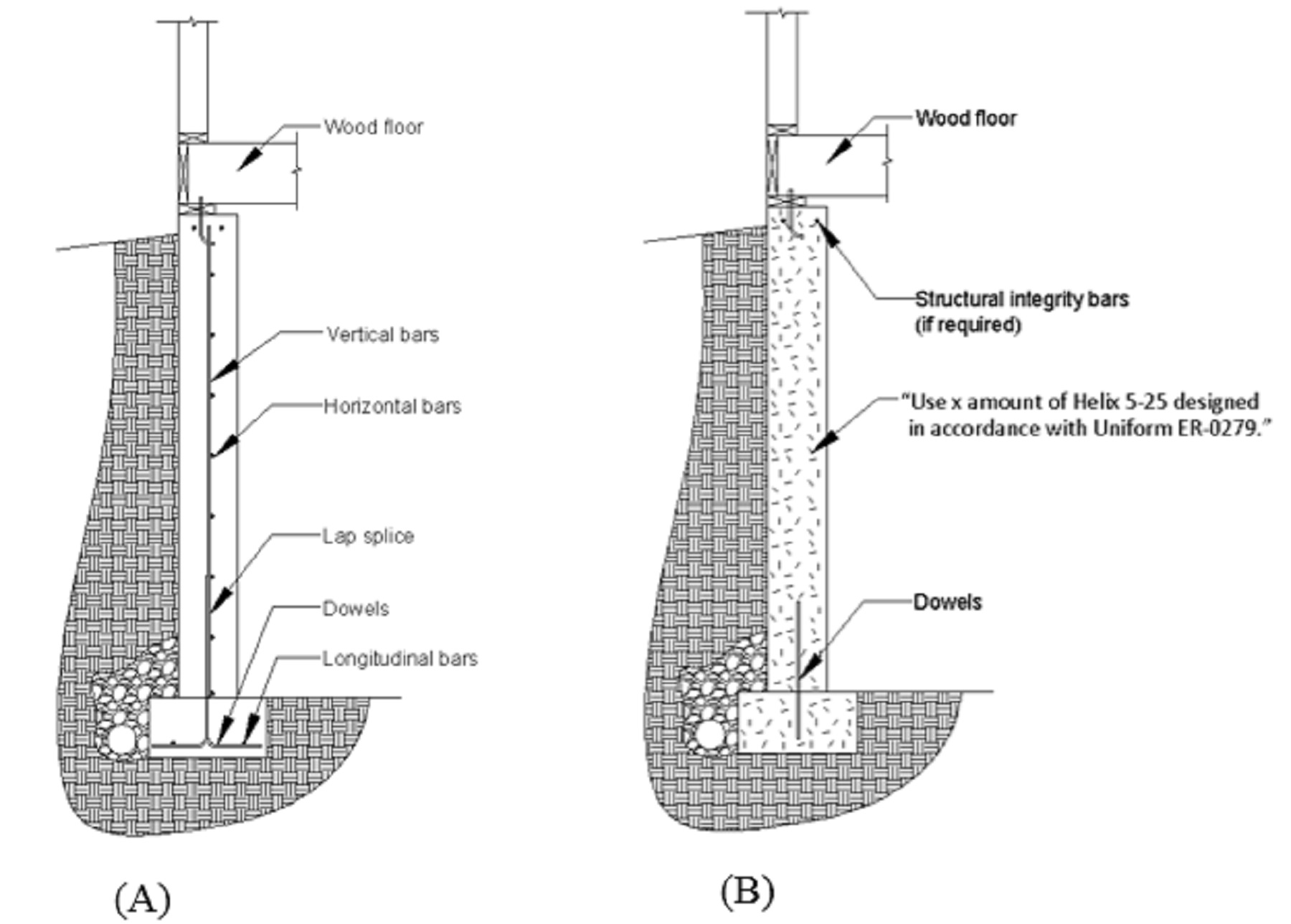
Figure 2. Concrete wall reinforcement with conventional rebar and TSMR
The purchase, delivery, cutting, bending and tying of rebar and mesh is time-consuming and costly. Placing the reinforcement at the specified depth is a critical step since the wall’s strength is decreased greatly when it is misplaced.
Building with TSMR eliminates placing errors since it is distributed throughout the concrete. Generally, TSMR is delivered to the job site already mixed in the concrete truck (Figure 3). The dosage of TSMR added to the mix should be noted on the batch ticket.
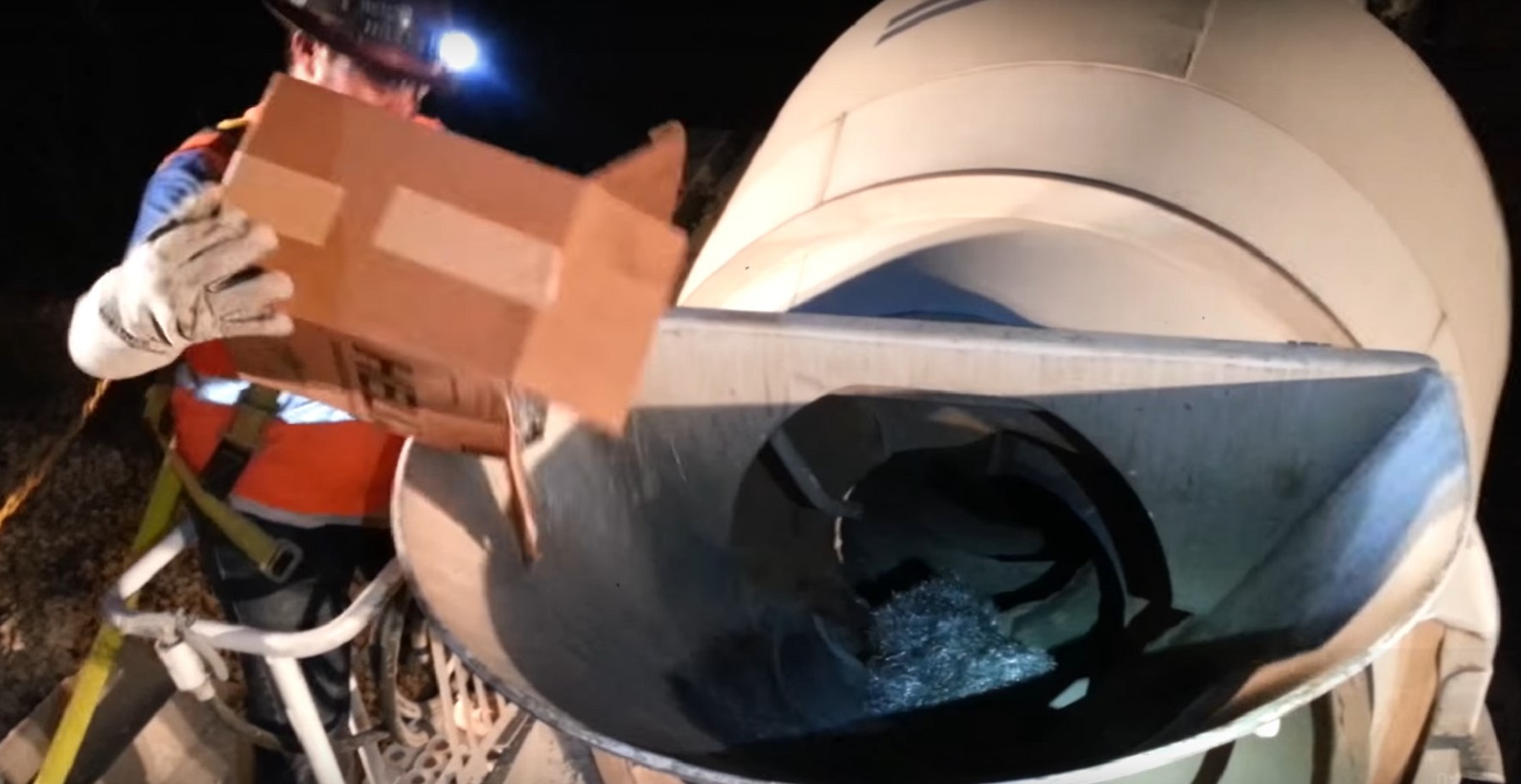
Figure 2. Mixing TSMR in concrete truck at job site.
Using TSMR reinforced concrete maximizes the speed and efficiency of construction. It also increases worksite safety by reducing injuries due to cuts (placing), strains (lifting), and tripping/falling (maneuvering on top of rebar) that are traditionally associated with rebar and mesh.
Wall Applications
TSMR has been used in concrete projects globally, with approvals in 99 countries. It has been used to replace reinforcement in above- and below-grade commercial and residential walls. Table 1 shows representative commercial wall projects. These projects illustrate the breadth of applications. The projects range from single-story houses to 25-story buildings. Too numerous to list, TSMR has also been used in thousands of residential projects in above- and below-grade foundation walls.
Table 1. Representative TSMR Commercial & Residential Wall Projects |
||||
Year |
Project |
Building type |
Wall thickness |
TSMR wall design |
2006-2016 |
The Villages Development
|
Over 8,000 single-story houses |
6 inches |
Full replacement of rebar
|
2006 |
Fairmont Village
|
3-story townhomes |
6 inches |
Full replacement of rebar
|
2008 |
St. Margaret Mary CatholicChurch
|
6-story church |
6-8 inches |
Partial replacement of rebar
|
2009 |
Holliday Inn Express
|
4-story hotel |
6 inches |
Full replacement of rebar
|
2012 |
12th Avenue Apartments
|
5-story apartments |
4, 6 & 8 inches |
Full replacement of rebar
|
2012 |
Pensmore Estate
|
5-story residence |
8 & 10 inches |
Partial replacement of rebar
|
2015 |
University of Waterloo
|
25-story dormitory |
10 inches |
Replaced one layer of rebar
|
2016 |
Hilton Garden Inn
|
5-story hotel |
4 & 6 inches |
Replaced horizontal rebar
|
2016 |
Indigo Green Apartments
|
Multiple 3-story apartments |
6 & 7 inches |
Replaced horizontal and reduced vertical rebar
|
2017 |
Hilton Garden Inn
|
5-story hotel |
4 & 6 inches |
Replaced horizontal rebar
|
2016 |
Helio Apartment Melbourne, Victoria, Australia |
16-story apartments |
6 inches |
Partial replacement of rebar
|
Carew Residence, Appleton, Wisconsin
At 13,200 square feet, the Carew home is anything but typical. In addition to living areas, the residence has a 34-foot-long indoor swimming pool, a full-size basketball court, a theater, wine cellar, and oval office with spectacular views of nearby Appleton, Wisconsin.
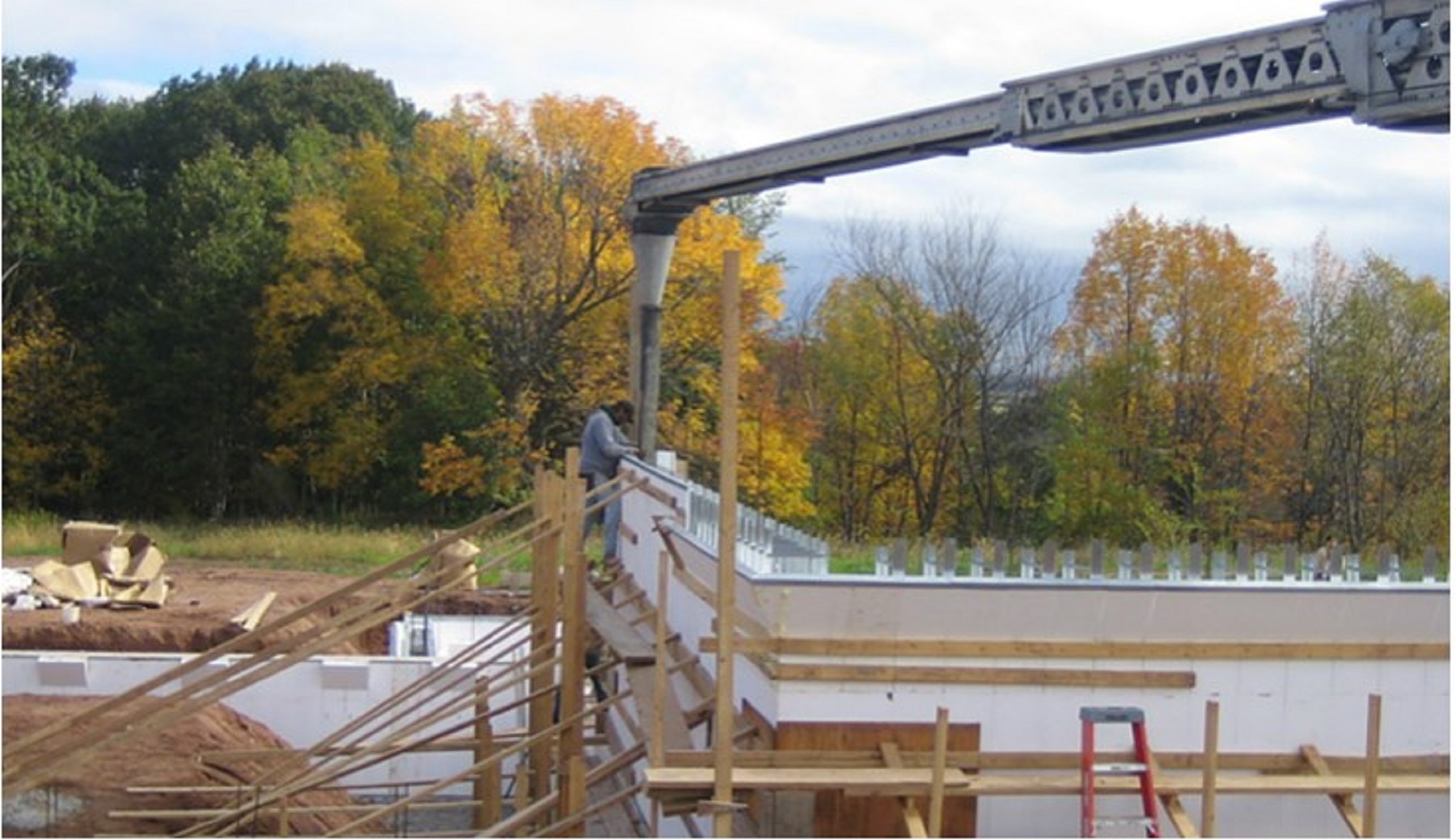
Figure 4. Carew Residence project.
The foundation walls, which used the TF Forming System’s vertically oriented ICF panel design, varied between 12 and 20 inches thick. Helix TSMR was added into the concrete ready-mix trucks and pumped into each wall segment, as seen in the picture below.
The Helix TSMR design for the foundation wall used 9 lb/yd3 to replace all of the vertical and horizontal rebar.
Richard Mortlock of TF Forming Systems said that “by incorporating Helix Steel in our design, we attained a higher level of structural reinforcement.”
Conclusion:
TSMR reinforced concrete refers to concrete reinforced with short, randomly oriented twisted steel filaments. TSMR is fully anchored in concrete using continuous twisted rib formations along the length of the shaft, similar to rebar. Because this type of reinforcement is distributed throughout the matrix and is fully anchored, it carries load both before and after the concrete develops cracks. In addition to its load-carrying capacity, TSMR provides redistribution of loads, potential reduction in crack widths, and increased durability of the finished structure. The degree to which these benefits are realized depends on the amount of TSMR added to the concrete mix. Although TSMR is not referenced in the IBC or IRC, the codes do allow the use of alternative products as long as they undergo a detailed review process (Section 104.11, 2015 IRC).
In order to successfully introduce any alternative product evaluation reports are used to help assess a product’s code compliance through the code specified AMC provision and are typically used for products or systems not addressed in the code. They are also provided to help the building official and design professional determine if products or systems meet the prescriptive requirements and/or intent of the code. Contractors, builders and engineers looking for such support have access to a Uniform-ES code approved evaluation report ER-0279 (5) completed by Helix in 2013. The ER-0279 states that Helix TSMR can be used in concrete reinforcement for walls and structural applications, which includes the residential concrete foundation wall. For more information, contact a Helix representative at 734-322-2114 or visit their website at www.helixsteel.com/residential.
About the Authors:
Samhar Hoz is a structural engineer at Helix Steel in Ann Arbor, Michigan. She has a master’s degree in engineering management from Eastern Michigan University. She has a Bachelor of Science in civil/structural engineering from Baghdad University. She has more than seven years’ experience in reinforced concrete structural design and construction for industrial and commercial projects. She is a secretary of two ACI 332 residential concrete work sub-committees.
Jeff Novak is vice president of engineering at Helix Steel in Ann Arbor, Michigan. He is responsible for the preparation of calculations for tunnel structures and building components using Helix concrete. He has more than 30 years’ experience in structural design of industrial and commercial projects. He earned a Bachelor of Science in civil engineering from the University of Maryland and an MBA from Kennesaw State University. He is subcommittee chairman of 506-b Fiber Reinforced Shotcrete and active on committees 506 Shotcrete, 360 Design of Slabs on Grade, and 544 Fiber Reinforced Concrete, and he is on American Society of Testing and Materials subcommittee C09.42 Fiber Reinforced Concrete.
Luke R. Pinkerton is president and chief technology officer at Helix Steel in Ann Arbor, Michigan. He has a Bachelor of Science in physics from Hope College and a Master of Science in civil/structural engineering from the University of Michigan, and he founded Helix Steel in 2002. He has 12 years of experience in reinforced concrete design, steel fiber design, non-linear finite element analysis, and blast and impact resistant design and testing. Luke is a member of ACI Committee 332, Residential Concrete Work and ASTM Concrete Pipe – C13.
Reference:
- American Concrete Institute. “Building code requirement for reinforced concrete.” (2014). ACI 318-14, Farmington Hills, Mich.
- American Concrete Institute. “Building code requirement for reinforced concrete.” (2014). ACI 332-14, Farmington Hills, Mich.
- International Code Council, 2015. Country Club Hills, Ill.
- Pinkerton, L.R. & Novak, J. (2014). Twisted steel micro-reinforcement – Advantages of microscopic composites. Concrete. 48. 36-37.
- Uniform Evaluation Service Evaluation report #297 (2013). Uniform Evaluation Service,. Ontario, Calif.
- Uniform Evaluation Service Evaluation Criteria #015 (2014). Uniform Evaluation Service, 5001 E. Philadelphia St. Ontario, CA 91761 – USA
UNDERSTANDING PYRRHOTITE IN CONCRETE
by James Baty, Gary Ehrlich, Jamie Farny, Don Penepent, and Dennis Purinton
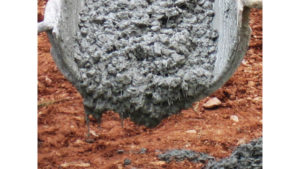 Concrete, the most widely used construction material in the world, is a complex matrix of materials that transforms into a reliable structural product. With so many variables—different ingredients, different performance requirements, varying exposures—specifiers are faced with many choices when designing durable concrete mixtures for the long term. Occasionally, concrete durability issues can arise when the structure is put into use.
Concrete, the most widely used construction material in the world, is a complex matrix of materials that transforms into a reliable structural product. With so many variables—different ingredients, different performance requirements, varying exposures—specifiers are faced with many choices when designing durable concrete mixtures for the long term. Occasionally, concrete durability issues can arise when the structure is put into use.
One such issue has been making headlines since at least 2010 in the state of Connecticut, pertaining to an expansive reaction of a specific, identifiable aggregate. A decade earlier, similar issues were identified in Quebec, and documented cases have occurred in many European countries. This article presents information surrounding the expansive reaction related to an iron-sulfide-containing aggregate called pyrrhotite.
Pyrrhotite is the suspected cause of concrete durability issues found in the northeast U.S. (Conn.), primarily used for residential foundations. The foundations of interest are experiencing a slow crack development, resulting in the eventual loss of concrete strength. The problems, sometimes exhibiting themselves within the first 10 years, often begin to show after 15 to 20 years or longer. Presently, the only known repair for the damaged foundations is removal and replacement of the affected concrete.
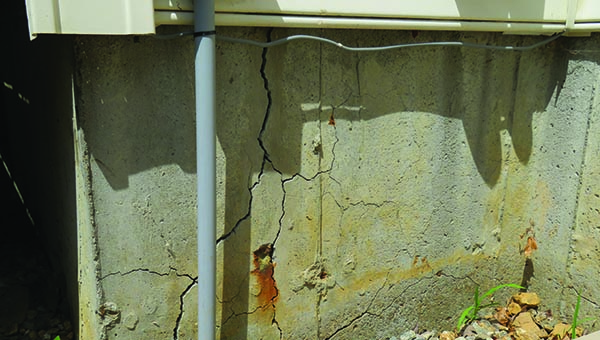
Figure 1. Typical cracking of pyrrhotite aggregate-affected concrete of a house foundation in Connecticut. Image courtesy of Michael Thomas.
For many reasons, the number of homes affected is unclear, but the problem has only been identified in four of the eight counties in Connecticut and in the Trois Rivieres area of Quebec, Canada. Homeowners in these areas are concerned and looking for assistance. Several concrete industry professionals are studying the issue to develop appropriate guidance. Meeting during conventions of the American Concrete Institute (ACI), participants from several committees impacted by the issue and research organizations offer their extensive knowledge of concrete and background in production and construction of these systems. Together they are well suited to adding some understanding to this issue.
As of spring 2017, two ACI committees—201, Durability of Concrete and 332, Residential Concrete Work—have agreed to look at the pyrrhotite issue in concrete. Not only is it important to make the industry aware of the issue, but it is also necessary to keep misinformation in check. ACI 201 has established a task group to study the issue and has been approved by the Institute to write a tech note, but that is expected to take some time to work its way through the committee process. In the meantime, this article is offered by representatives of the Portland Cement Association, the Concrete Foundations Association, the National Ready Mix Concrete Association, and the National Association of Home Builders, as these are some of the industry groups affected by this phenomenon. The article is intended to raise awareness of this durability issue by describing materials, exposure conditions, deterioration, and other countries’ experience with the problem, and by presenting the current best practices that can help prevent future occurrences of such pyrrhotite aggregate reaction.
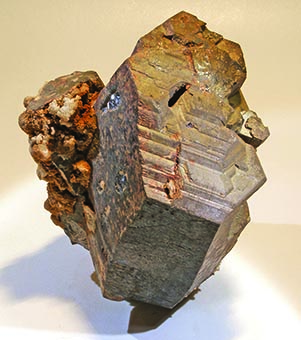
Figure 2. Pyrrhotite aggregate.
What Is the Pyrrhotite Aggregate?
The deteriorating foundations are associated with a quarried rock that contains a mineral called pyrrhotite (Figure 2). Pyrrhotite is the second most common iron sulfide in nature, and it is found associated with pyrite, marcasite, magnetite, and chalcopyrite (CSA 2014). Even so, aggregate that contains pyrrhotite, an unstable form of iron sulfide (Fe[1-x]S), in quantities that are able to be disruptive to concrete does not appear to be very common.
In Connecticut, this aggregate came from a specific quarry and was used in concrete supplied from one producer starting in the late 1980s and continuing until 2015. In Canada, the aggregate came from two quarries in Quebec. For various reasons, aggregate sources are not normally evaluated for pyrrhotite. Furthermore, as will be demonstrated in this article, identifying this aggregate may require that specialized testing be developed.
At this time, it is not yet known if testing all aggregate supplies for this sulfide mineral is necessary. Quarry owners, aggregate producers, ready mixed concrete producers, and others, whether in the affected areas or elsewhere, are rightly interested in making sure that any recommendations that are made about this issue be based on good science. Until it is understood exactly how much pyrrhotite causes problems, avoiding it entirely seems to be warranted. But identifying its occurrence in aggregate materials is itself fraught with difficulty. Some have said it is a bit like looking for a needle in a haystack. That places more of a burden on developing identification tests, because it is not possible to test every single piece of aggregate, so some representative portion of it must serve as a proxy for the entire source. Those researching this issue agree that if testing is to be done, the required tests must be practical as well as effective for industry and consumers to have confidence in them.
Production of Concrete – The Constituents
People familiar with concrete know that it contains a limited number of materials: fine and coarse aggregates, cementitious material(s), water, and, usually, admixtures. Most concrete is produced with potable water. Cementitious materials include portland cement, blended cement, hydraulic cement, and other supplementary cementitious materials, such as fly ash and slag, the two most common. Admixtures commonly used include air-entrainers, water reducers, set retarders, and set accelerators.
Fine and coarse aggregates comprise the largest portion of concrete, commonly 60 percent to 75 percent by volume. It is in the coarse aggregates that pyrrhotite is most concerning in regard to durability.
Reactive Aggregates in Concrete
Pyrrhotite expansion can be considered an aggregate durability issue (CSA 2014). The pyrrhotite particles in coarse aggregate are unstable in oxidizing conditions. Although the mechanism(s) of deterioration are not completely understood, the following summary appears to be supported: When exposed to water and oxygen, the sulfide minerals oxidize to form acidic-, iron-, and sulfate-rich by-products (CSA 2014). One of these products is sulfuric acid, which results in an acid attack on (primarily the portlandite in) the cement paste, weakening the paste, with sulfates as a by-product. These sulfates react with portlandite and hydrated aluminate phases in the paste, resulting in expansion, as happens in classical sulfate attack.
Deterioration typically consists of expansion, map cracking, popouts, white rims surrounding the aggregate particles, and yellowish discoloration near the cracks. In some cases, affected concrete can become so friable that it can almost be removed by hand (Rodrigues et al 2016). Although some of the basic deterioration mechanism seems to be known, this remains a relatively uncommon problem. Therefore, several aspects of this reaction need to be further observed in order to be better understood and be able to provide adequate guidance.
Canadian, European, and Other Countries’ Experience
The Canadian industry has been working on the pyrrhotite in concrete issue for many years, and CSA A23.1 provides some guidance. Annex P (non-mandatory) recommends that new and unproven sources of concrete aggregate be tested for sulfur content (CSA 2014). They note that many aggregates contain small amounts of sulfides, so it would be unrealistic to set a limit of 0.1 percent for sulfur content. That is why it may be more feasible to follow what the European standards recommend for aggregates—a recommendation developed over several decades, as reported by Rodrigues et al. (2016):
- France originally adopted a 1 percent sulfate (SO3) limit, with a max 0.4 percent sulfur (S).
- The broader European standards specify 1 percent S by mass for aggregates other than air-cooled blast furnace slag, or 2 percent S by mass of S for air-cooled blast furnace slag.
- 1 percent S limit for aggregates proven to contain pyrrhotite.
At present, there is no accelerated physical test method to assess the potential for expansion of concrete due to the oxidation of iron sulfides, but Canadian researchers have been working on a performance test that is based on an oxygen consumption test used to evaluate sulfide mineral content in mine tailings (Mbonimpa et al. 2011).
Foundation Exposure
Walls for residential foundations may be partially or completely below ground. It is this type of exposure that provides adequate moisture and oxygen for this durability issue to be of concern when some (or a significant quantity of) pyrrhotite is present in the aggregate. It is the “safe” level that is still not known with certainty. Below-grade exposures are susceptible to damage because the ground moisture is regularly present below grade and residential concrete, when unregulated, can have a higher water-cementitious ratio than many other types of concrete construction. Concrete with a higher water-cementitious ratio, which is more permeable, allows for easier ingress of moisture and oxygen. This was confirmed by Canadian research in the 1970s by Berard et al., who found that concrete with a lower cement content deteriorated more quickly than concrete of higher cement content or lower water-cement ratio.
After prolonged exposure to oxygen and moisture, pyrrhotite reacts to create secondary minerals that can cause expansion. The aggregate basically rusts, and two expansive sulfate products are formed (gypsum and ettringite). Because concrete has a much lower tensile strength than compressive strength (about 10 percent), typical residential concrete of 2,500–4,000 psi (17–28 MPa) compressive strength would only have a tensile strength on the order of 250–400 psi (about 1.7–2.8 MPa). As such, it does not have a lot of capacity to resist tensile forces caused by the expansive mechanisms. The reaction also produces iron oxides, which may contribute to expansive stresses.
Another study on deterioration found that the type of aggregate and the permeability of the concrete play a role in the rate of oxidation of iron sulfides, and that the high pH of concrete increases the oxidation rate (Divet 1996, Divet and Davy 1996).
More needs to be learned about the deterioration mechanism before specific guidance can be provided. It is not yet clear if the concrete itself contains enough water for the reaction to proceed if good waterproofing materials are applied properly, but limiting the amount of ground moisture that can infiltrate the concrete is certainly good practice. Low permeability concrete can be achieved with lower w/cm and use of supplementary cementitious materials.
Long-Term Durability of Concrete
Damage occurs at a faster rate in lower quality concrete, but even better-quality concrete that contains pyrrhotite is likely to be susceptible to this deterioration, given enough time and the proper conditions. As noted earlier, the concrete may start to show signs of deterioration within a few years, or it may take more than 10 or 15 years to start exhibiting problems. For these reasons, avoiding the susceptible aggregate is the current recommended best practice to assure concrete durability.
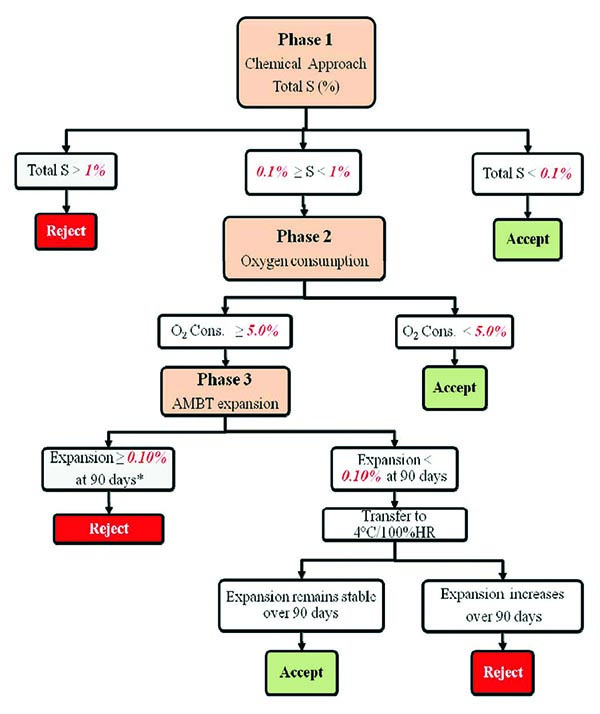
Fig. 3—Proposed protocol for determining potential reactivity of iron sulfide bearing aggregates. Numbers in italics represent limit values that still need to be validated through testing of wider range of aggregate materials. (*Cause of excessive expansion—that is, ASR and/or oxidation of sulfide minerals—should be addressed before rejecting aggregate.) (Rodrigues et al 2016)
Conclusions
Although this phenomenon appears to be geographically limited, there are potentially large numbers of homes already affected or at risk of developing this durability problem. Remediation of affected concrete does not seem to be an option, at least not for the most severe occurrences of pyrrhotite expansion. In those cases, the only solution to the problem is removal and replacement of the foundation with new concrete that does not contain pyrrhotite aggregate.
In addition to understanding how to remediate affected basements, it may also be necessary to institute appropriate aggregate testing procedures. It still is not known if testing will be recommended only in areas that are known to have this type of aggregate in their quarries or if it will include other areas.
Researchers continue to study the problem to understand it. As more is known about it, educating the concrete industry will become more important, from increasing awareness to explaining the preferred approaches for lessening the potential for future occurrences of the issue.
About the Authors
James R. Baty II, FACI, is executive director for the Concrete Foundations Association, representing a professional network of contractors, engineers, builders and ready mix suppliers engaged in the residential foundation industry across North America. He can be reached at 319-895-6940 or by email at jbaty@cfaconcretepros.org.
Gary Ehrlich is a director of codes and standards for the National Association of Home Builders, which strives to protect the American Dream of housing opportunities for all. He works to achieve professional success for members who build communities, create jobs and strengthen our economy. He can be reached at 202-266-8545 or by email at gehrlich@nahb.org.
Jamie Farny is the director of building marketing for the Portland Cement Association, which is dedicated to improving and extending the uses of portland cement and concrete in the United States through market development, engineering, research, education, and public affairs work. He can reached at 847-972-9172 or by email at jfarny@cement.org.
Don Penepent is the Ready Mix Division Manager for Tilcon Connecticut, Inc (an Oldcastle Company). He has been managing concrete operations and designing mixes for various applications for over 40 years. He can be reached at 860-612-5104 or by email at dpenepent@tilcon-inc.com.
Dennis Purinton is president of Purinton Builders of East Granby, Conn. and current president of the Concrete Foundations Association. His company has been installing residential and commercial foundations for 35 years. He is an active member of ACI 332, 306, and 655 committees. He can be reached at 860-670-1791 or by email at purintonbuilders@yahoo.com.
The authors would like to thank several individuals who reviewed this article:
Michael Thomas, professor of civil engineering at the University of New Brunswick, Fredericton, NB, Canada
Paul Tennis, director of product standards and technology at Portland Cement Association
Benoit Fournier, associate professor, Department of Geology and Geological Engineering at the University of Laval, Quebec City, QC, Canada
References
Berard, J., R. Roux and M. Durand. “Performance of concrete containing a variety of black shale.” Canadian Journal of Civil Engineering, vol. 2, 1975. pp. 58–65.
CSA 2014. Concrete materials and methods of concrete construction/Test methods and standard practices for concrete – Annex P Impact of sulphides in concrete aggregate on concrete behavior. CSA A23.1-14, CSA Group, Aug. 2014.
Divet, L. “Activité sulfatique dans les bétons consécutive à l’oxydation des pyrites continues dans les granulats: Synthèse bibliographique.” Bulletin des Laboratoires des Ponts et Chaussées, vol. 201, 1996. pp. 45–63.
Divet, L., J-P. Davy. “Étude des risques d’oxydation de la pyrite dans le milieu basique du béton.” Bulletin des Laboratoires des Ponts et Chaussées, vol. 204, 1996. pp. 97–107.
Mbonimpa, M., M. Aubertin, and B. Bussiere. “Oxygen consumption test to evaluate the diffusive flux into reactive tailings: interpretation and numerical assessment.” Canadian Geotechnical Journal, vol. 48, 2011. pp. 878–890.
Rodrigues, A., J. Duchesne, B. Fournier, B. Durand, M. H. Shehata, and P. Rivard. “Evaluation Protocol for Concrete Aggregates Containing Iron Sulfide Minerals.” ACI Materials Journal, vol. 113, no. 3, 2016.
3 Tips from a Seasoned Concrete Contractor
Follow these ideas to become a more profitable contractor.

“Stag Pool Party” Scene from commercial by Farmer’s Insurance – Oct 27, 2014 (c) Farmer’s Insurance
In the Farmers Insurance commercials, the tagline is: “We know a thing or two, because we’ve seen a thing or two.” I feel the same way about the concrete construction industry. I’ve seen a lot of changes in the industry, as well as noticing that some fundamental truths never change. I’ve made a lot of mistakes, and even learned from a few of them to become a better contractor.
Following are three tips I’d like to share with you that can help you improve your concrete construction company.
Always Be Selling & Marketing
The old adage, “Nothing happens until someone sells something,” is brilliantly simple, yet powerful. Without effective sales and marketing, companies cannot reach their revenue and profit goals.
Many contractors stop selling and marketing when their schedule fills up. Then, when their backlog dwindles down to a few jobs, they scramble to keep their crews busy. They cut their prices in order to get work quickly.
Their workload increases, but it’s at low profit margins. With a backlog of work again, they stop selling and marketing. As this cycle repeats itself, contractors find themselves with profit margins lower than what they should be.
It’s important to keep your sales and marketing funnel full, regardless of your backlog. As your schedule fills up, continue selling—but raise your pricing on new estimates. Your bid/win ratio will suffer, but the jobs that you do get will be at higher profits. Adjust your pricing based on your backlog, but don’t stop selling.
By maintaining your sales and marketing efforts, you’ll still have a lot of deal flow when your work begins to slow down. You simply drop down to your standard pricing to increase the amount of jobs you need to keep your crews busy. This is much different than panicking when you don’t have work and cutting your prices to unprofitable levels.
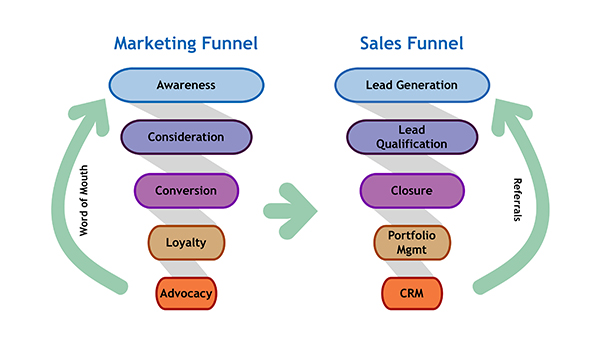
Labor Is Crucial
Your ability to attract, hire, train and retain good employees will determine your company’s success in the coming years. While having the right people on board has always been important, in the last four years it has become every contractor’s top concern.
Contractors across all trades are experiencing hiring headaches. The good news is that if you can be just 20 percent better than other contractors at hiring, training and retaining good people, then you’ll have a huge competitive advantage. You’ll be able to take market share from your competitors. And, most importantly, you’ll be able to make more money on every job.
For many contractors, the Human Resources (HR) side of the business is a necessary evil. You’ve needed to have someone within the company handle payroll, worker’s compensation and employee benefits. Business owners would much rather be out in the field where the work is being done. However, your HR activities will have to play a larger role in your company. More resources will have to be allocated to HR. More time and energy will have to be spent learning how to hire smarter, train faster, and keep your people longer than you have in the past. Your HR person(s) will have to be better than other contractors in your market in the war for good employees.
In today’s business climate, every dollar you invest in the HR side of your business will produce higher returns than ever before.
One Is a Dangerous Number
For anything in your business, one is a dangerous number. One estimator, one layout person, one layout instrument, one bookkeeper, one boom truck, one boom truck driver, one customer that accounts for more than 25 percent of your work.
 Whenever you have just one of anything in your company, you are in a vulnerable position. If that one person left, or that one vehicle broke down, or that one customer left you, your company would have a very difficult time recovering. In certain instances, it could cause the company to go out of business.
Whenever you have just one of anything in your company, you are in a vulnerable position. If that one person left, or that one vehicle broke down, or that one customer left you, your company would have a very difficult time recovering. In certain instances, it could cause the company to go out of business.
Look at every aspect of your company and ask yourself where you have just “one” of someone or something. If you are like most concrete contractors, you’ll find plenty of areas that fit that description. While it can be impractical—if not close to impossible—to add a second one of everything, think about how you can reduce your exposure. Where can you cross-train someone who could fill in for the primary person? If a piece of equipment goes down, could you rent something similar, or hire another contractor to help out? For the customer that is responsible for 32 percent of your revenue, what prospects could you sell that could reduce that high percentage of work?
Begin looking at your vulnerable areas and develop plans to reduce your exposure. Then, work on those plans until you have good back-ups in each area. Don’t wait to work on this until you lose your “one.”
If you can make improvements in response to all three tips I’ve given you, then you’ll be far ahead of other contractors in your area. You’ll be in a much less vulnerable position, and you’ll be a more profitable contractor.
Letter from the Director: Endings Really Are New Beginnings
Over the last few months I have been reminded time and time again of the impact companies and leaders in this Association have had on the blueprint for this industry and the legacy they have left behind. I have such vivid memories of leaders like Ron Colvin (p.17, 19), a former president of the CFA, whose vision set the stage for great challenges to our commitment to educating the next generation of business owners. Passionate members, like Mahlon Eash Jr. (p. 19) who display pure joy and hunger for learning during our meetings, always showing up to Convention with the biggest of smiles and always eager to engage peers are what this Association is about and why it was made. There will always be threads of their conviction and their participation. They modeled what it means to be involved in a network, working to better a company, standing alongside others who are willing to listen and contribute.
I have revisited their stories and have learned more about them through their family stories told in obituary notices and convyed to me by people that were much closer to them. In doing so, what strikes me the most is how the stories don’t end now. RC’s legacy is already continuing through his children’s conviction to the foundation he laid, running a business known for its quality and commitment in southwest Michigan. Another contractor I have periodically communicated with but didn’t have the chance to know very well, was Dave Mongillo from Connecticut, who passed suddenly last October. His leadership has led one of his superintendents of 37 years to pick up the pieces and carry on. In each, as with Foundations Plus (Mahlon Eash), what might normally be a series of endings is already transitioning to become a series of new beginnings.
How appropriate that you are reading this in such a transitional month as March. World of Concrete 2018 is behind us already. Two hundred fifty people turned out for the CFA’s Winter Social held at the Hard Rock Café @ The Strip where all conveyed how energized the gathering was. The impact of winter is ending; what breaks before us now is the promise of an even stronger 2018 than what 2017 offered. The new beginning found in the promise of spring—and resumed full construction activity unencumbered by freezing temperatures and mixed precipitation conditions—is, itself, electric in potential. With this electricity, the CFA is alive with new prospects, new members and intentional growth of program resources for this industry. Check out the article from the Safety Committee (p. 25) describing the hard work that has already been given to this Association by safety professionals and dedicated employees of companies just like yours, that aren’t CFA Board members or company owners. Yes, alive at this time and moving in new beginnings is the reality that now more than ever, concrete contractors need a network, support, resources and ways to have vision beyond the day-to-day activity that otherwise fogs the windshield of direction.
I am humbled to be at the helm of this Association, having had the chance to work alongside such great individuals as Ron and Mahlon, and to work for the hundreds—nay, thousands—more that will be impacted by the efforts of these member companies. The reality is that so much more is to be gained by having a hand in the mix than just watching for the news.

James Baty
Executive Director
jbaty@cfaconcretepros.org
319-895-6940
Letter from the President
For many of us the usual winter weather has generated scheduling problems, loss of work volume, and many unproductive days.
On the brighter side, we have all been blessed with the ability to be profitable by the plentiful volume of work during the nicer seasons of the year, I call this “inside the box work” because it is easy to get.
Now is a great time to venture into “outside of the box” work. Historically, work outside of the box has far less competition. The competitors for this work understand the importance of investment in necessary equipment and the expertise required to complete this work very profitably. In some cases, the investment in new equipment can be recovered on that specific job. The other option, of course, is to rent necessary equipment short-term that may be easier to recover costs specific to the job. Add in some in-house expertise and you have broadened your profit center.
“If you are willing to do more than you are paid to do, eventually you will be paid to do more than you do.”
(anonymous)
We all need to keep in mind that times are not always going to be good. The profitable work will become marginal and the very profitable work will become profitable. Outside-of-the-box work is normally still available when times get tough. Always remember, there are many CFA members willing to provide assistance or guidance in pursuing this type of work.
On another note, I wanted to thank all of our members (contractors and associates) for their support at the winter meeting and at the show in Las Vegas last month. I felt the World of Concrete was a great event this year, as was the CFA winter meeting and social event at the Hard Rock Café. I was able to speak with many new members as well as potential new members.
Next up is the summer meeting in Utah. This year’s summer meeting is shaping up to be one of the best events ever. We have a spectacular line up of speakers whose information will be valuable in increasing your bottom line. The list of participating vendors is also growing, providing our members with more product information in one place. In addition to attending a great educational event, the Zermatt resort will be a great place to bring your family, with a wide variety of activities for all ages.
We hope to see everyone there.

Dennis Purinton
Purinton Builders Inc.
purintonbuilders@yahoo.com
2017 Product & Services Showcase
This feature brings you the current products & services that may be found represented by the member companies of the Concrete Foundations Association to make the work of concrete contractors more efficient and of higher quality.
PRODUCT & SERVICES SHOWCASE
AUTOCAR | www.autocartruck.com | 877-973-3486
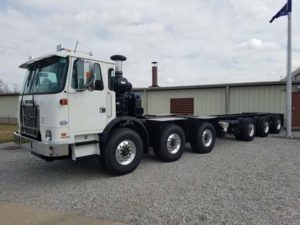 At Autocar, building trucks isn’t just what we do – it’s our way of life. Autocar is a leading U.S. based manufacturer of heavy duty vocational trucks for applications like, mobile cranes, terminal tractors and concrete boom pump chassis. We could say a lot of fancy things about our research and technology. We could talk about our experience. We could tell you about our customer service. It’s probably what you’re expecting – but you’ll find all that on our web pages. We’re not here to rest on our laurels. To truly understand Autocar, all you need to know is that we’re 100% niche application-focused because we know you are, too.
At Autocar, building trucks isn’t just what we do – it’s our way of life. Autocar is a leading U.S. based manufacturer of heavy duty vocational trucks for applications like, mobile cranes, terminal tractors and concrete boom pump chassis. We could say a lot of fancy things about our research and technology. We could talk about our experience. We could tell you about our customer service. It’s probably what you’re expecting – but you’ll find all that on our web pages. We’re not here to rest on our laurels. To truly understand Autocar, all you need to know is that we’re 100% niche application-focused because we know you are, too.
Boman Kemp | bomankemp.com | 800-733-7886
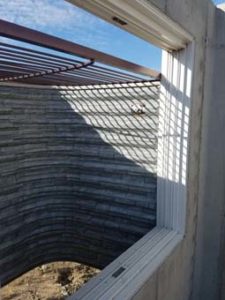 Introducing a new vinyl window buck. Features tie slots on 3-foot centers. Available in widths of 7 1/2, 8, 9 1/2, 10, 11 1/2 and 12 inches. Low-E Argon dual sliding windows. Well attachment bolts. Welded corners with steel strength built into a finished frame.
Introducing a new vinyl window buck. Features tie slots on 3-foot centers. Available in widths of 7 1/2, 8, 9 1/2, 10, 11 1/2 and 12 inches. Low-E Argon dual sliding windows. Well attachment bolts. Welded corners with steel strength built into a finished frame.
Concrete Forms Services | ezfootings.com | 801-280-6992
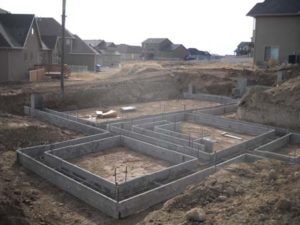 Here at EZ-Footings™ we have designed precise concrete forms out of lightweight, remarkably strong aluminum. With these footing forms you can have a snap-together concrete forming system that will reduce your labor costs up to 50 percent. Additionally, you’ll also see cost savings on concrete, wood, nails and on the fuel to transport your equipment. We’ve thought of everything to enhance simplicity; and your end results will be better than you’ve ever seen.
Here at EZ-Footings™ we have designed precise concrete forms out of lightweight, remarkably strong aluminum. With these footing forms you can have a snap-together concrete forming system that will reduce your labor costs up to 50 percent. Additionally, you’ll also see cost savings on concrete, wood, nails and on the fuel to transport your equipment. We’ve thought of everything to enhance simplicity; and your end results will be better than you’ve ever seen.
Concrete Pump Supply | concretepumpsupply.com | 877-434-PUMP
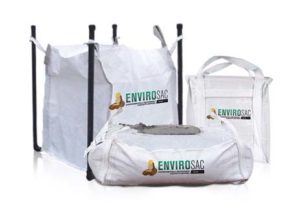 Envirosac concrete washout bags offer a bag for every aspect of the concrete placement industry. Our bags are a comprehensive solution from priming out all the way to cleaning out the hopper or drum. These portable lined bags ensure you always have a secure and environmentally friendly solution for leftover concrete.
Envirosac concrete washout bags offer a bag for every aspect of the concrete placement industry. Our bags are a comprehensive solution from priming out all the way to cleaning out the hopper or drum. These portable lined bags ensure you always have a secure and environmentally friendly solution for leftover concrete.
Cornerstone Innovations | www.permaformicf.com | 641-425-0028
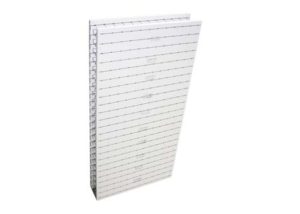 Perma Form is a complete, prefabricated concrete wall-forming system for commercial or residential use. These panels arrive fully assembled at the jobsite and are easily connected with built-in interlocking fingers, allowing a durable wall to be quickly formed.
Perma Form is a complete, prefabricated concrete wall-forming system for commercial or residential use. These panels arrive fully assembled at the jobsite and are easily connected with built-in interlocking fingers, allowing a durable wall to be quickly formed.
Cranes and Equipment | www.cranesequip.com | 800-682-1022
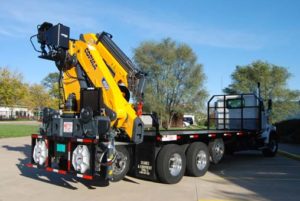 Fully hydraulic Copma form-handling cranes. No electronics, no sensors, no computers. Jib or non-jib cranes available, with reaches of 66 to 84 feet, and maximum capacities from 1,800 to 2,300 pounds. Need larger or smaller? We can provide it. The Copma 450 jib crane provides reach and lift options of 2,250 pounds at 70 feet 8 inches, 2,000 pounds at 78 feet 9 inches, or 1,800 pounds at 84 feet 8 inches. Stop by Cranes & Equipment’s WOC booth #C4834! Ask about our show specials and check out our form-handling package with the Copma 450.6J3.
Fully hydraulic Copma form-handling cranes. No electronics, no sensors, no computers. Jib or non-jib cranes available, with reaches of 66 to 84 feet, and maximum capacities from 1,800 to 2,300 pounds. Need larger or smaller? We can provide it. The Copma 450 jib crane provides reach and lift options of 2,250 pounds at 70 feet 8 inches, 2,000 pounds at 78 feet 9 inches, or 1,800 pounds at 84 feet 8 inches. Stop by Cranes & Equipment’s WOC booth #C4834! Ask about our show specials and check out our form-handling package with the Copma 450.6J3.
Dörken Systems, Inc. | www.dorken.com | 888-433-5824
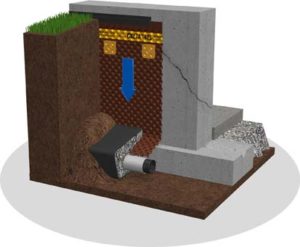 DELTA®-MS provides reliable protection for permanently dry basements, keeping moisture away from foundation walls. Air-gap Technology membrane allows incidental moisture that does get past to drain harmlessly to the footer drain. DELTA®-MS is tough and durable. It keeps basements dry and comfortable even when the concrete foundation wall cracks – something asphaltic dampproofing spray can’t do. Dörken delivers innovative, high-performance air and moisture barriers for commercial and residential construction sold under the DELTA® brand name. DЪrken is known for delivering premium products while providing educational programs and full technical support.
DELTA®-MS provides reliable protection for permanently dry basements, keeping moisture away from foundation walls. Air-gap Technology membrane allows incidental moisture that does get past to drain harmlessly to the footer drain. DELTA®-MS is tough and durable. It keeps basements dry and comfortable even when the concrete foundation wall cracks – something asphaltic dampproofing spray can’t do. Dörken delivers innovative, high-performance air and moisture barriers for commercial and residential construction sold under the DELTA® brand name. DЪrken is known for delivering premium products while providing educational programs and full technical support.
Euclid Chemical | www.euclidchemical.com | 800-321-7628
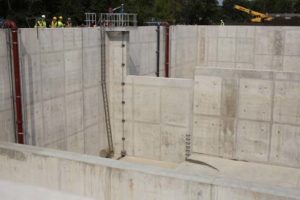 For over 100 years, Euclid Chemical has served as a leading supplier to the concrete and masonry industry, offering a full line of engineered concrete admixture and construction products, including chemical admixtures, block and masonry additives, fibers, curing and sealing compounds, epoxy adhesives, floor and wall coatings, structural grouts for columns, equipment and machinery, joint fillers, and repair products. Euclid Chemical’s TUF-STRAND SF macro-synthetic fibers can be used to replace conventional steel reinforcing in poured wall systems and other concrete structures with accompanied engineered calculations and professional design services.
For over 100 years, Euclid Chemical has served as a leading supplier to the concrete and masonry industry, offering a full line of engineered concrete admixture and construction products, including chemical admixtures, block and masonry additives, fibers, curing and sealing compounds, epoxy adhesives, floor and wall coatings, structural grouts for columns, equipment and machinery, joint fillers, and repair products. Euclid Chemical’s TUF-STRAND SF macro-synthetic fibers can be used to replace conventional steel reinforcing in poured wall systems and other concrete structures with accompanied engineered calculations and professional design services.
Fox Blocks | www.FoxBlocks.com | 877-369-2562
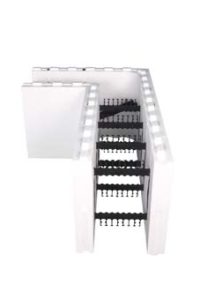 After decades of experience and innovation in the ICF industry, Fox Blocks backs up our products with the support, service and delivery that builders and designers expect. In 2006, after 20 years of producing all brands of ICFs, Airlite introduced the Fox Blocks ICF brand as the latest generation of insulated concrete form available from the manufacturer to the market.
After decades of experience and innovation in the ICF industry, Fox Blocks backs up our products with the support, service and delivery that builders and designers expect. In 2006, after 20 years of producing all brands of ICFs, Airlite introduced the Fox Blocks ICF brand as the latest generation of insulated concrete form available from the manufacturer to the market.
GDB Software, Inc. | www.GDBsoftware.com | 800-845-6642
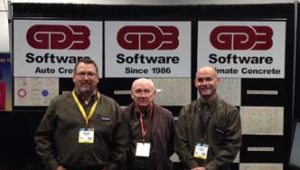 GDB Software has developed CAD and estimating software specifically designed for the concrete foundation and form-rental industries for over 32 years. The software designers and developers at GDB Software have been in the concrete foundation industry and know your software needs. In those 32 years GDB Software has devoted its time to developing software specifically for the Concrete and Form Rental companies’ needs and has been family owned and operated since day one.
GDB Software has developed CAD and estimating software specifically designed for the concrete foundation and form-rental industries for over 32 years. The software designers and developers at GDB Software have been in the concrete foundation industry and know your software needs. In those 32 years GDB Software has devoted its time to developing software specifically for the Concrete and Form Rental companies’ needs and has been family owned and operated since day one.
GMX Waterproofing | www.gmxwaterproofing.com | 704-334-8222
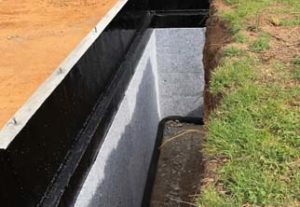 Better drainage, superior durability, competitively priced, environmentally friendly, flexible and bends easily. And it doesn’t itch! What more needs to be said? Fiberglass protection boards just can’t match the standard of excellence set by GMX’s Thermal Drain. Thermal Drain can be ordered in R-3, R-5 and R-10 versions with board thicknesses of 3/4, 1-3/16 and 2-3/8 inches. GMX manufactures waterproofing systems for the residential market and a full line of commercial waterproofing products and systems. Since 1895, GMX has provided solutions for the most challenging waterproofing problems. We welcome the opportunity to put our experience at your service.
Better drainage, superior durability, competitively priced, environmentally friendly, flexible and bends easily. And it doesn’t itch! What more needs to be said? Fiberglass protection boards just can’t match the standard of excellence set by GMX’s Thermal Drain. Thermal Drain can be ordered in R-3, R-5 and R-10 versions with board thicknesses of 3/4, 1-3/16 and 2-3/8 inches. GMX manufactures waterproofing systems for the residential market and a full line of commercial waterproofing products and systems. Since 1895, GMX has provided solutions for the most challenging waterproofing problems. We welcome the opportunity to put our experience at your service.
Grip-Tite Manufacturing | www.griptite.com | 800-474-4878
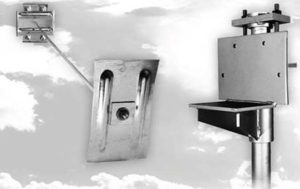 Grip-Tite, founded in 1921, is a leading manufacturer and distributor of engineered products for foundation repair and support. Products include the Grip-Tite® Foundation Pier System, Helical Pile and Anchor Systems, and the Wall Anchor System. Foundation repair products for bowed, bulging and cracked foundation walls, piers for sinking or settling foundations, and new construction and tie-back/soil nailing products are available through our network of certified, trained dealers. Grip-Tite also offers state-of-the-art water control and water-proofing systems designed to keep basements healthy for your family. Dealer opportunities are available in limited areas. Contact us at info@griptite.com.
Grip-Tite, founded in 1921, is a leading manufacturer and distributor of engineered products for foundation repair and support. Products include the Grip-Tite® Foundation Pier System, Helical Pile and Anchor Systems, and the Wall Anchor System. Foundation repair products for bowed, bulging and cracked foundation walls, piers for sinking or settling foundations, and new construction and tie-back/soil nailing products are available through our network of certified, trained dealers. Grip-Tite also offers state-of-the-art water control and water-proofing systems designed to keep basements healthy for your family. Dealer opportunities are available in limited areas. Contact us at info@griptite.com.
Mar-Flex Waterproofing Products | www.mar-flex.com | 800-498-1411
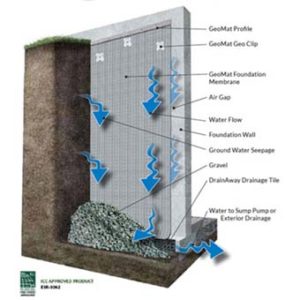 GeoMat+ and GeoMat drainage rolls remove water and resist hydrostatic pressure by channeling below-grade water towards footer drainage systems. These water channels are created by molding high-density polyethylene (HDPE) into sheets featuring vertically and horizontally aligned dimples, acting as a barrier to protect liquid membranes against back-fill soil and sediment. The GeoMat product line can complement and protect a spray-on waterproofing or damp-proofing membrane. In instances where a drainage system is installed, GeoMat may be used as a dampproofing product as well as a waterproofing membrane. GeoMat accessories are available to facilitate any job and make installation easy.
GeoMat+ and GeoMat drainage rolls remove water and resist hydrostatic pressure by channeling below-grade water towards footer drainage systems. These water channels are created by molding high-density polyethylene (HDPE) into sheets featuring vertically and horizontally aligned dimples, acting as a barrier to protect liquid membranes against back-fill soil and sediment. The GeoMat product line can complement and protect a spray-on waterproofing or damp-proofing membrane. In instances where a drainage system is installed, GeoMat may be used as a dampproofing product as well as a waterproofing membrane. GeoMat accessories are available to facilitate any job and make installation easy.
Monarch Materials Group | www.monmatgrp.com | 412-605-2625
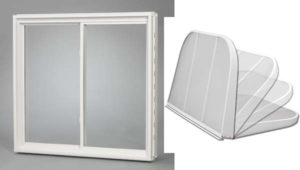 Premier Vinyl Window is designed for pour-in-place systems. It features a sloped sill for water removal, and both sashes are removable and fully weather-stripped. Removable bracing maintains a square window during and after concrete placement. Frames extend the entire width of the wall for thermal efficiency, and the frame has a built-in, tie-slot mounting system. Thermal Hinge Cover keeps wells dry and debris-free while protecting your family, friends, and pets. It supports up to 44 pounds per square foot and is sloped for rain, ice and snow runoff. Fluted design of polycarbonate increases any basement window’s thermal performance.
Premier Vinyl Window is designed for pour-in-place systems. It features a sloped sill for water removal, and both sashes are removable and fully weather-stripped. Removable bracing maintains a square window during and after concrete placement. Frames extend the entire width of the wall for thermal efficiency, and the frame has a built-in, tie-slot mounting system. Thermal Hinge Cover keeps wells dry and debris-free while protecting your family, friends, and pets. It supports up to 44 pounds per square foot and is sloped for rain, ice and snow runoff. Fluted design of polycarbonate increases any basement window’s thermal performance.
North American Specialty Products | www.royalbuildingproducts.com | 713-585-2618
 FORM-A-DRAIN® is the 3-in-1 foundation solution that forms footings, provides an integrated drainage system, and is adapted to vent radon where needed. Designed for residential basement applications, Form-A-Drain consists of lineal sections installed as the foundation footing forms. Unlike standard wood forms, Form-A-Drain stays in place permanently after completion of the concrete pour and forms a complete sub-slab perimeter loop around the foundation. Since it stays in place, Form-A-Drain shaves valuable time from the construction schedule; there’s no need for a crew to return the next day to remove, strip, clean and transport forms to the next job site.
FORM-A-DRAIN® is the 3-in-1 foundation solution that forms footings, provides an integrated drainage system, and is adapted to vent radon where needed. Designed for residential basement applications, Form-A-Drain consists of lineal sections installed as the foundation footing forms. Unlike standard wood forms, Form-A-Drain stays in place permanently after completion of the concrete pour and forms a complete sub-slab perimeter loop around the foundation. Since it stays in place, Form-A-Drain shaves valuable time from the construction schedule; there’s no need for a crew to return the next day to remove, strip, clean and transport forms to the next job site.
Nox-Crete Products Group | www.nox-crete.com | 402-504-9241
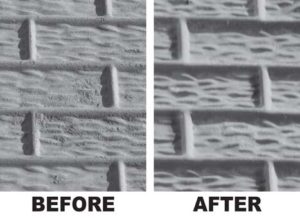 Now is a great time to clean your aluminum forms…the easy way! Fall and winter is a great time to start thinking about how to remove hard concrete buildup from your aluminum forms. Form Clean is a powerful, chemically active, dual purpose product designed to quickly soften hard concrete buildup while also working as a form release agent. Using Form Clean as a replacement for your everyday form release agent for 2 – 3 weeks is generally sufficient to remove most concrete buildup. Once your forms are clean, you can switch back to your everyday release agent. If your aluminum forms accumulate more buildup, simply switch back to Form Clean to soften and remove the buildup.
Now is a great time to clean your aluminum forms…the easy way! Fall and winter is a great time to start thinking about how to remove hard concrete buildup from your aluminum forms. Form Clean is a powerful, chemically active, dual purpose product designed to quickly soften hard concrete buildup while also working as a form release agent. Using Form Clean as a replacement for your everyday form release agent for 2 – 3 weeks is generally sufficient to remove most concrete buildup. Once your forms are clean, you can switch back to your everyday release agent. If your aluminum forms accumulate more buildup, simply switch back to Form Clean to soften and remove the buildup.
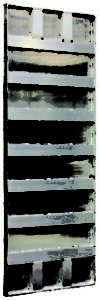
Precise Forms Inc. | www.preciseforms.com | 816-690-3400
Precise Forms manufactures a wide variety of high-quality aluminum forming systems that can exceed over 2,500 pours with proper care. These systems can be used for, but are not limited to: basements, concrete homes, multi-story buildings, international projects and precast. The forming systems are produced using state-of-the-art robotic welding and create a beautiful concrete finish. These easy-to-use systems require minimal training and help reduce your labor costs. Precise Forms offers a full line of fillers and accessories in both smooth and decorative form styles.
Prinsco | www.prinsco.com | 419-906-9101
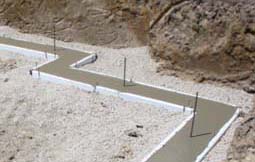 PROFORM™ HD (Heavy Duty) is an innovative, efficient alternative to traditional wood or PVC forms. This dual-wall corrugated HDPE system forms the footings while at the same time providing superior drainage and radon venting – all in one easy step! PROFORM HD is durable, easy to cut, cold-weather and impact resistant, and comes with installed couplers.
PROFORM™ HD (Heavy Duty) is an innovative, efficient alternative to traditional wood or PVC forms. This dual-wall corrugated HDPE system forms the footings while at the same time providing superior drainage and radon venting – all in one easy step! PROFORM HD is durable, easy to cut, cold-weather and impact resistant, and comes with installed couplers.
Professional Products Direct | www.professionalproductsdirect.com | 530-605-6846
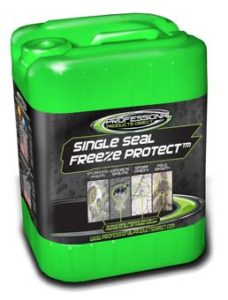 This is perhaps the most versatile concrete sealer, hardener, retardant, freeze protectant, and cure on the market today – it can be used in the most extreme conditions (120 F to below freezing, -20 F) and WITHOUT A CONCRETE BLANKET. One application of Single Seal & Freeze Protect offers the benefits of having a completely sealed concrete but leaves the substrate surface completely receptive to all paints, topical sealers (urethanes, epoxies, acrylics, and glues), weather breathable or non-breathable. This offers added protection preventing the separation milking your topcoat might have caused by moisture and water released by unsealed concrete.
This is perhaps the most versatile concrete sealer, hardener, retardant, freeze protectant, and cure on the market today – it can be used in the most extreme conditions (120 F to below freezing, -20 F) and WITHOUT A CONCRETE BLANKET. One application of Single Seal & Freeze Protect offers the benefits of having a completely sealed concrete but leaves the substrate surface completely receptive to all paints, topical sealers (urethanes, epoxies, acrylics, and glues), weather breathable or non-breathable. This offers added protection preventing the separation milking your topcoat might have caused by moisture and water released by unsealed concrete.
Putzmeister | www.putzmeisteramerica.com | 262-884-6387
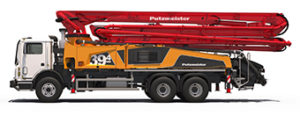 Putzmeister will introduce its redesigned 30-meter class Truck-Mounted Concrete Boom Pumps line in 2018. Every model in the 30-meter class features improvements based on customer feedback and features a common pedestal. The 31Z-Meter features a new robust pedestal with the same boom with a modified and lengthened first section to account for its offset head. The 36Z-Meter includes a new boom, a more robust pedestal, and even more flexible supports. The 38Z-Meter boom also features a more robust pedestal. The brand-new 39Z-Meter features an innovative boom design, robust pedestal design, and can be configured to meet virtually any pumping application.
Putzmeister will introduce its redesigned 30-meter class Truck-Mounted Concrete Boom Pumps line in 2018. Every model in the 30-meter class features improvements based on customer feedback and features a common pedestal. The 31Z-Meter features a new robust pedestal with the same boom with a modified and lengthened first section to account for its offset head. The 36Z-Meter includes a new boom, a more robust pedestal, and even more flexible supports. The 38Z-Meter boom also features a more robust pedestal. The brand-new 39Z-Meter features an innovative boom design, robust pedestal design, and can be configured to meet virtually any pumping application.
Robotics Surveying Solutions | scarter@xmission.com | 801-201-9510
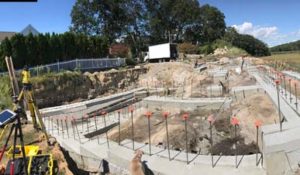 We provide equipment, training and support for well over 90 percent of the members of the CFA using robotic layout systems nationwide. Experience with different equipment manufacturers for over 30 years, we sell and specialize only in layout. Each system sold comes with two to three days of on-site training to achieve desired results. We offer system demonstrations, we provide attractive finance programs and we also provide contacts for CAD training and software. Watch for “Robotic Layout Systems Updates” that go out to all CFA members several times a year.
We provide equipment, training and support for well over 90 percent of the members of the CFA using robotic layout systems nationwide. Experience with different equipment manufacturers for over 30 years, we sell and specialize only in layout. Each system sold comes with two to three days of on-site training to achieve desired results. We offer system demonstrations, we provide attractive finance programs and we also provide contacts for CAD training and software. Watch for “Robotic Layout Systems Updates” that go out to all CFA members several times a year.
Rockwell Inc. | www.rockwellinc.com | 301-606-6165
 RockWell manufactures stone textured window wells with the look and feel of real stone adding an aesthetically pleasing view from inside and outside your home. Our Egress window wells are IRC Code compliant, and because they are made of fiberglass, they are extremely durable, and come with a ten-year warranty. They are available in sizes from 24 to 96 inches in height in tan or grey.
RockWell manufactures stone textured window wells with the look and feel of real stone adding an aesthetically pleasing view from inside and outside your home. Our Egress window wells are IRC Code compliant, and because they are made of fiberglass, they are extremely durable, and come with a ten-year warranty. They are available in sizes from 24 to 96 inches in height in tan or grey.
Scott System, Inc. | www.scottsystem.com | 303-373-2500
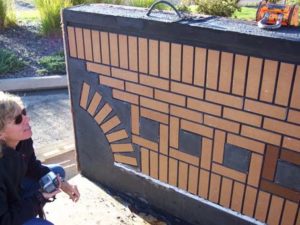 The Scott Rim Snap product is designed to hold thin brick vertical in poured-in-place forms. They are reusable at least three times because of the elastomeric rim that holds the brick while forming the mortar joint between the bricks. The Snaps will be “snapped” together and stapled onto the plywood form surface, then thin brick will be pressed into the Snap for a tight fit with no leakage. It is a simple process with outstanding results. A poured-in-place concrete wall with a real brick façade.
The Scott Rim Snap product is designed to hold thin brick vertical in poured-in-place forms. They are reusable at least three times because of the elastomeric rim that holds the brick while forming the mortar joint between the bricks. The Snaps will be “snapped” together and stapled onto the plywood form surface, then thin brick will be pressed into the Snap for a tight fit with no leakage. It is a simple process with outstanding results. A poured-in-place concrete wall with a real brick façade.
SLS Financial | www.slsfinancial.com | 816-423-8021
 Today, credit scoring systems can make credit decisions almost instantly. While convenient, business is still about people. More than ever, business owners seek a commercial lending partner to learn about their unique needs and to be solution-providers. At SLS, we’ve never lost focus of the business owner behind the application. A big part of our success is based on customer satisfaction, plain and simple, because we believe in leveraging technology and combining it with our expertise for only one purpose: to help people. Should you have questions, we’d welcome a conversation that makes business lending uncomplicated. Call Doug anytime.
Today, credit scoring systems can make credit decisions almost instantly. While convenient, business is still about people. More than ever, business owners seek a commercial lending partner to learn about their unique needs and to be solution-providers. At SLS, we’ve never lost focus of the business owner behind the application. A big part of our success is based on customer satisfaction, plain and simple, because we believe in leveraging technology and combining it with our expertise for only one purpose: to help people. Should you have questions, we’d welcome a conversation that makes business lending uncomplicated. Call Doug anytime.
Starlite Leasing, Inc. | www.starliteleasing.net | 317-873-9728 ext. 222
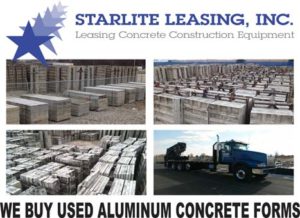 Starlite Leasing Inc. is a concrete construction leasing company that specializes in helping small and medium-sized businesses, like yours, acquire the equipment they need today. We also buy and sell aluminum concrete forms and rentals by the week or month. We carry a large inventory of new and used aluminum forms, fillers and baskets.
Starlite Leasing Inc. is a concrete construction leasing company that specializes in helping small and medium-sized businesses, like yours, acquire the equipment they need today. We also buy and sell aluminum concrete forms and rentals by the week or month. We carry a large inventory of new and used aluminum forms, fillers and baskets.
Thermomass | www.thermomass.com | 800-232-1748
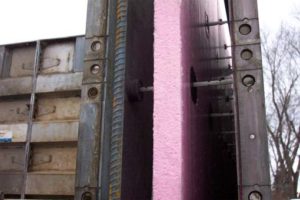 For over 35 years, Thermomass System CIP has been used by contractors to integrally insulate cast-in-place concrete walls. The system is unique in that it allows a layer of insulation to be placed into a vertically cast concrete wall using traditional forming equipment and construction practices. Unlike traditional ICF forms and post-insulated concrete blocks, Thermomass System CIP insulation and connectors allow both the interior and exterior layers of concrete to be left exposed and finished in a variety of methods, resulting in a durable, energy-efficient building envelope that is free from common moisture concerns and maintenance issues.
For over 35 years, Thermomass System CIP has been used by contractors to integrally insulate cast-in-place concrete walls. The system is unique in that it allows a layer of insulation to be placed into a vertically cast concrete wall using traditional forming equipment and construction practices. Unlike traditional ICF forms and post-insulated concrete blocks, Thermomass System CIP insulation and connectors allow both the interior and exterior layers of concrete to be left exposed and finished in a variety of methods, resulting in a durable, energy-efficient building envelope that is free from common moisture concerns and maintenance issues.
Tremco Barrier Solutions | www.tremcobarriersolutions.com | 614-322-4446
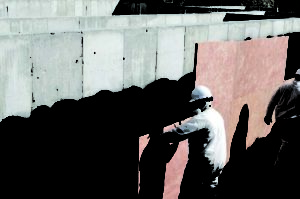 TUFF-N-DRI® and Watchdog Waterproofing® Quick Cure – these innovative waterproofing formulations from Tremco Barrier Solutions cure at a rate that is up to 90 percent faster than our standard market-leading products, opening up a wider weather window of opportunity for you to confidently meet your production schedules, keep your builders happy and improve your bottom line. Quick Cure can be used on every job you spray, and it’s greatest value to you and your builder is when it’s sprayed with rain, sleet or snow in the forecast and you need to get a job done NOW!
TUFF-N-DRI® and Watchdog Waterproofing® Quick Cure – these innovative waterproofing formulations from Tremco Barrier Solutions cure at a rate that is up to 90 percent faster than our standard market-leading products, opening up a wider weather window of opportunity for you to confidently meet your production schedules, keep your builders happy and improve your bottom line. Quick Cure can be used on every job you spray, and it’s greatest value to you and your builder is when it’s sprayed with rain, sleet or snow in the forecast and you need to get a job done NOW!
V&H Inc. | www.vhtrucks.com | 800-826-2308
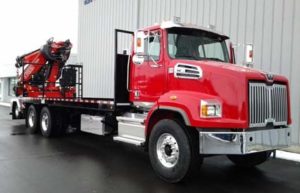 V&H Inc. will be showing the two leaders in the market in one great package! Western Star 4700SB, the toughest work truck on the market today, packaged with the leading form-handling crane on the market, Fassi. The 4700SB has the best turning radius, toughest frame and the new Allison 4700 – 7 speed, full auto transmission. The Fassi F415RA.2.24L414 crane is equipped with top seat and the HBC radio remote. It also features a flow-sharing digital hydraulic distributor and RCH evolution remote system. Stop at the Fassi booth #C6103 and ask for Perry Peterson.
V&H Inc. will be showing the two leaders in the market in one great package! Western Star 4700SB, the toughest work truck on the market today, packaged with the leading form-handling crane on the market, Fassi. The 4700SB has the best turning radius, toughest frame and the new Allison 4700 – 7 speed, full auto transmission. The Fassi F415RA.2.24L414 crane is equipped with top seat and the HBC radio remote. It also features a flow-sharing digital hydraulic distributor and RCH evolution remote system. Stop at the Fassi booth #C6103 and ask for Perry Peterson.
Fleetmatics, A Verizon Company | www.fleetmatics.com | 866-844-2235
 Fleetmatics REVEAL is a fleet management software that has easy-to-understand features that can help you run your fleet like never before. Get visibility into vehicle location, fuel usage, speed, mileage, and valuable insights into driver behavior. With the likes of custom reporting, near real-time alerts, and Geofences, your fleet will be working with efficiency you’ve only dreamt of. Our easy-to-use web-based and mobile fleet tracking applications allow you to simply and affordably improve the way you manage your vehicles.
Fleetmatics REVEAL is a fleet management software that has easy-to-understand features that can help you run your fleet like never before. Get visibility into vehicle location, fuel usage, speed, mileage, and valuable insights into driver behavior. With the likes of custom reporting, near real-time alerts, and Geofences, your fleet will be working with efficiency you’ve only dreamt of. Our easy-to-use web-based and mobile fleet tracking applications allow you to simply and affordably improve the way you manage your vehicles.
Western Forms | www.westernforms.com | 913-787-5366
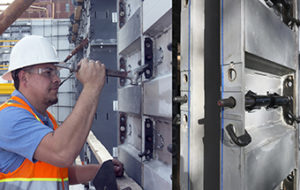 Western Forms have the highest resale value of any aluminum forms in the world, featuring the original patented “PinLock™ Attached Hardware” and “Gasket” side rails. PinLock™ is faster and easier than any other attached hardware system, connecting forms 30%+ faster than pins and wedges. The self-cleaning, self-lubricating, spring loaded system makes operation fast and smooth. Exclusive “Gasket” reduces cleaning time, increases form life, helps maintain trade-in value. Western Forms forming systems are made in the USA with American materials, designed to reduce labor, crew hours, and length of projects while still providing high quality structures. Contact Western Forms to learn more.
Western Forms have the highest resale value of any aluminum forms in the world, featuring the original patented “PinLock™ Attached Hardware” and “Gasket” side rails. PinLock™ is faster and easier than any other attached hardware system, connecting forms 30%+ faster than pins and wedges. The self-cleaning, self-lubricating, spring loaded system makes operation fast and smooth. Exclusive “Gasket” reduces cleaning time, increases form life, helps maintain trade-in value. Western Forms forming systems are made in the USA with American materials, designed to reduce labor, crew hours, and length of projects while still providing high quality structures. Contact Western Forms to learn more.
Westminster Hydraulics | www.WestminsterHydraulics.com | 888-818-4402
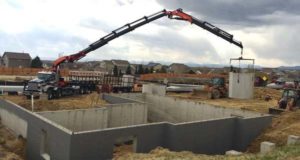 For over 35 years, privately owned and operated Westminster Hydraulics Inc. has been recognized as one of the leading truck-mounted equipment installation facilities in the Mid-Atlantic region. We’re a small business that takes great pride in producing the highest quality custom products and creating long-lasting relationships based on our total commitment to customer satisfaction. “Quality Isn’t Expensive…It’s Priceless.”
For over 35 years, privately owned and operated Westminster Hydraulics Inc. has been recognized as one of the leading truck-mounted equipment installation facilities in the Mid-Atlantic region. We’re a small business that takes great pride in producing the highest quality custom products and creating long-lasting relationships based on our total commitment to customer satisfaction. “Quality Isn’t Expensive…It’s Priceless.”
Letter from the Director: OSHA Regulations Bring Increased Relevance
Just from the title, I presume you have already slid to the edge of your seat or crossed your arms in frustration or defiance for what you might read in this letter. After all, in the marketplace there are more real cases now than ever before of contractors and projects impacted by the increased attention OSHA has given to this industry.
Consider this for a moment, however: all reputable contractors realize the most valuable resource and number-one capital investment of their business is the workforce. Labor management is really what your company is about and it likely always has been. The rare exception is the owner/operator, one- or two-man crew that is able to still get by on talent and reliance on equipment and technology. And yet, even you—owner/operator, one- or two-man crew—are your own most valuable resource.
Therefore, what is the biggest concern when it comes to regulations that are designed to do one thing, to keep your most valuable resource safe and in excellent working condition? The reality is that, given best intent (which I know is arguable), OSHA and the research committees that feed their decision-making do not have the time, resources or expertise to truly understand the nature of your work and determine the best ways to regulate safety—or do they? The CFA is currently working hard to answer this question and to provide assistance for all companies in the foundation construction business.
OSHA regulations are all about an employer’s duty to create and maintain safe working conditions, no matter the cost. If you have just invested a large amount of money in the newest piece of equipment (e.g. a concrete pump) or the latest technology (e.g. robotic layout station), are you not willing to spend extra time protecting, cleaning and preparing every precaution to keep that investment in top shape for as long as possible? This is what understanding OSHA regulations is all about. It is not picking your way through a list of options for the quickest way to comply or ignoring regulations on the assumption that you understand your business better.
In the past two months, we have received an increased number of communications for member companies being impacted by OSHA site visits. Citations are being issued for excavation, fall protection, PPE, awareness, on-site management and much more. Silica has yet to be cited but we expect it to be in the conversation soon. Your best course of action to take as soon as possible is to thoroughly review your safety plans, introductions, maintenance and education. There are safety consultants we can introduce you to and, most importantly, CFA members have access to our complimentary preparation resources, review and prevention services.
Accidents will happen to even the most prepared company. However, anticipating and minimizing the nature of a potential accident and preparing for the consequences is our responsibility. We know your business and are intent on helping OSHA know it even more (i.e. alliance for the same common goal), and we want to help you succeed at protecting what we can all agree needs to be protected.
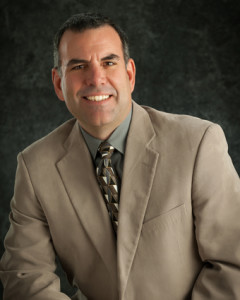
CFA Executive Director, James Baty | jbaty@cfaconcretepros.org
Letter from the President: Business Does Not Change Effectiveness
It has been a very busy year for both our company and the association. We left the summer
meeting with renewed enthusiasm for our business and, equally important, enthusiasm for
subject areas the CFA needed to address.
We live in an ever-changing world, and I have come to realize and understand the need to
run our businesses differently than we have in the past. The handshake days and the readily
available, high-quality, experienced labor pool is all but gone. These two areas are target
issues the CFA is addressing through education and business programming.
“If you are willing to do more than you are paid to do, eventually you will be paid to do more than you do.”
(anonymous)
A comprehensive safety and compliance program for the concrete industry is well
underway. We have a very active Safety Committee with professional help available to
them to develop a comprehensive all- inclusive Safety Program. We are also looking into
a national alliance program with OSHA to see if that type of relationship might benefit
our organization and industry. Education sessions generated by these programs will help
in alleviating OSHA citations of noncompliance that are becoming more common in our
industry. I believe we all have the same common goal of increasing safety awareness and
understanding.
On a different note, you have probably heard many of us talk about “the CFA experience”
and I would like to share one with you. The Bartley Corp. and our company shared
workforces and experience on a job this summer. It has been said that “you don’t know
what you don’t know.” This experience made me realize what I did know, but I hadn’t
realized the potential value it would have to both of our companies. We learned a lot from
each other. This was a perfect example of a true “CFA experience.”
Making a similar effort to find ways for your employees to share their experiences with
those from another company can be an eye-opener and a game-changer. This experience
now tops my list of CFA experiences and is a highlight of my career.
The CFA is here to represent the interests and needs of our industry. Realistically, this
can only happen with input from each and every one of you. We would like to know what
information or issues you would like to see addressed that are pertinent to you and your
company. We welcome your input, questions, concerns and suggested areas of need.
I hope to see everyone in Las Vegas in January at the World of Concrete. Please stop by to
visit us at the CFA Booth.

Dennis Purinton
Purinton Builders Inc.
purintonbuilders@yahoo.com
Tricks of the Trade: Rebar Racks for Crew Trucks
This issue’s Trick of the Trade is shared by CFA member, Doug Herbert of Herbert Construction in Marietta, GA. Doug continues the challenge to you the reader to think about the ways you’ve overcome annoying details and situations to be more effective and economical in your work. If you are from an active CFA member company and your trick is selected for publication, your company will have 50 pts. placed in your account for Member Rewards redeemable for your CFA transactions. If you are from a company that is not a member, we will offer you a $100 discount on your first year’s membership fees…a great way to get to know the CFA.
A couple of years ago, the Concrete Foundations Association sponsored a visit to CFA member ABI Corporation in Missouri. My dad, Barry Herbert, and I were with a group of member contractors that visited their office, shop and yard to see how they do things. Dan and Mike Bromley and their staff at ABI Corp. opened their doors and shared their business with us.
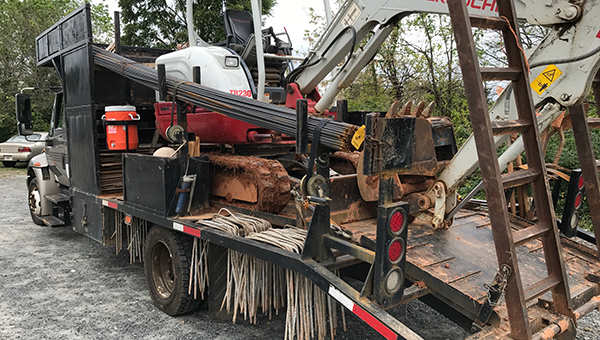 One of the many interesting things I saw there was how they carried their rebar on their trucks. They had tilted their rebar racks downwards towards the rear of the truck. Instead of placing the rebar on top of a tall, level truck rack, this angled rack was a simple stroke of genius.
One of the many interesting things I saw there was how they carried their rebar on their trucks. They had tilted their rebar racks downwards towards the rear of the truck. Instead of placing the rebar on top of a tall, level truck rack, this angled rack was a simple stroke of genius.
The sloped rack made it much easier on their employees. They no longer had to climb up onto the bumper or bed of the truck and reach overhead to pull the rebar off. It was a lot more efficient and productive to simply stand on the ground, grab a handful of rebar, and drag it off the truck.
The rebar bundles could still be loaded onto the sloped rack with a forklift in their yard, so loading time was not affected.
A few months after visiting ABI Corp., we were designing a new footing crew truck and added this feature to our design. It has worked really well for us and we will be sure to do that for any other new trucks we fabricate.
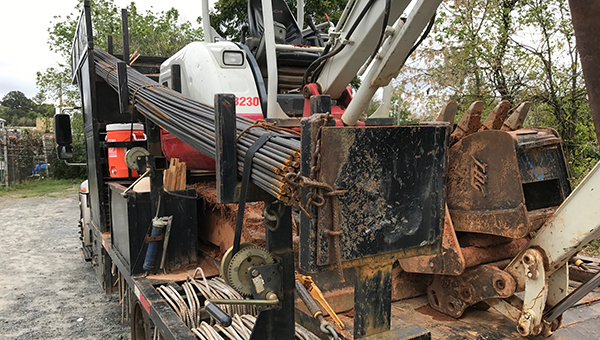 The design has saved us many man-hours on various job sites. And we have certainly eliminated one area for possible slips and falls, which reduces potential worker’s compensation claims.
The design has saved us many man-hours on various job sites. And we have certainly eliminated one area for possible slips and falls, which reduces potential worker’s compensation claims.
By the way, the biggest benefit of being a member of the Concrete Foundations Association is networking with other successful contractors and vendors to learn better ways of running your business.
Over the years we have gotten numerous ideas like this that have helped our company. Those ideas have improved our working conditions, reduced our headaches, increased our profit, and paid for our membership a hundred times over.
Special thanks to Dan and Mike Bromley and everyone at ABI Corp. for their original idea.







